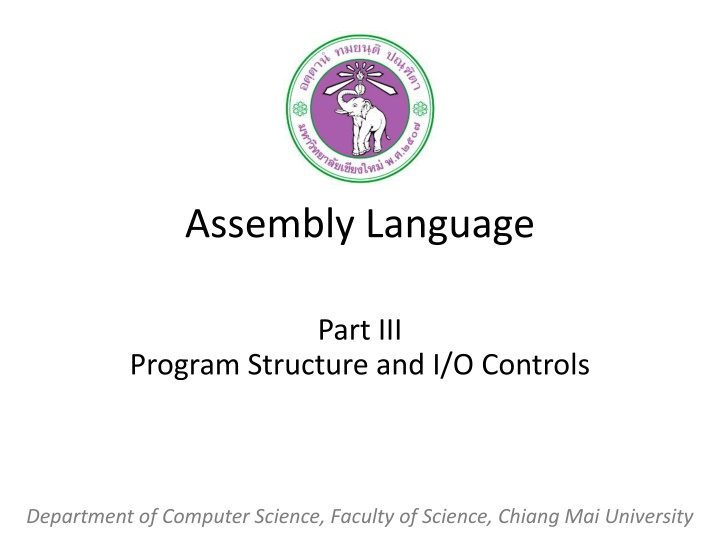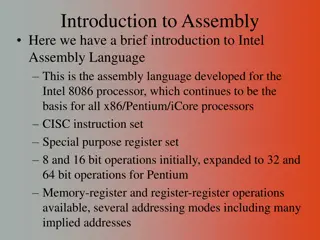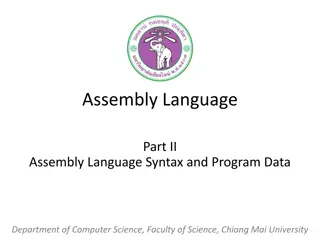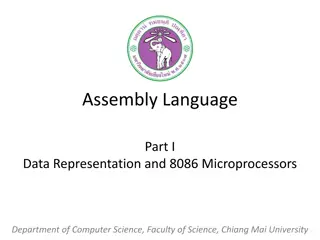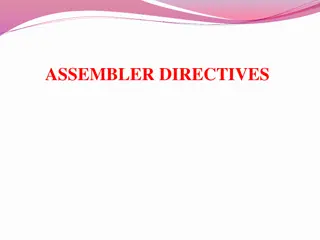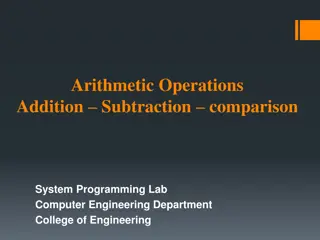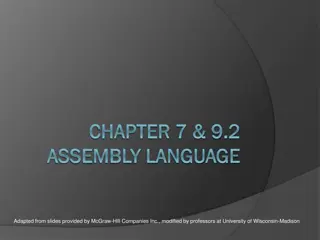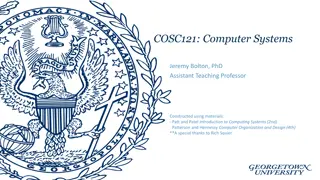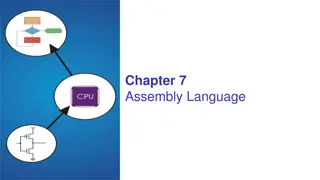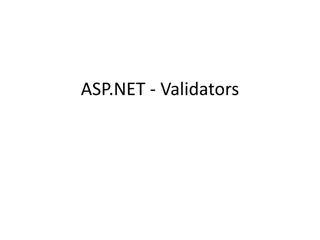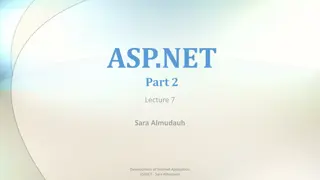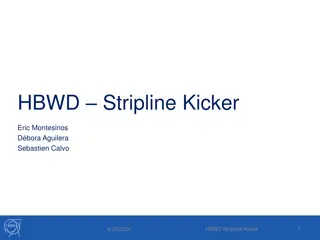Assembly Language Part III Program Structure and I/O Controls
Assembly Language Part III explores program structure, input-output controls, and macro programming. It covers topics such as displaying strings, case conversion, creating and running programs, memory models, data segments, stack segments, code segments, and program organization. The content delves into the details of defining variables and constants, allocating memory, setting stack segments, arranging code instructions, and overall program implementation.
Download Presentation

Please find below an Image/Link to download the presentation.
The content on the website is provided AS IS for your information and personal use only. It may not be sold, licensed, or shared on other websites without obtaining consent from the author.If you encounter any issues during the download, it is possible that the publisher has removed the file from their server.
You are allowed to download the files provided on this website for personal or commercial use, subject to the condition that they are used lawfully. All files are the property of their respective owners.
The content on the website is provided AS IS for your information and personal use only. It may not be sold, licensed, or shared on other websites without obtaining consent from the author.
E N D
Presentation Transcript
Assembly Language Part III Program Structure and I/O Controls Department of Computer Science, Faculty of Science, Chiang Mai University
Outline Program Structure Input-Output control and macro programming A First Program Displaying a String A Case Conversion Program Creating and Running a Program 2 204231: Computer Organization and Architecture
Memory Models Model SMALL Description code in one segment data in one segment code in more than one segment data in one segment code in one segment data in more than one segment code in more than one segment data in more than one segment no array larger than 64k bytes code in more than one segment data in more than one segment arrays may be larger than 64k bytes MEDIUM COMPACT LARGE HUGE 3 204231: Computer Organization and Architecture
Data Segment A program s data segment contains all the variable definitions. Constant definitions are often made here as well, but they may be placed elsewhere in the program since no memory allocation is involved. 4 204231: Computer Organization and Architecture
Stack Segment The purpose of the stack segment declaration is to set aside a block of memory (the stack area) to store the stack. The stack area should be big enough to contain the stack at its maximum size. 100h bytes for the stack area is a reasonable size for most applications 5 204231: Computer Organization and Architecture
Code Segment The code segment contains a program s instructions. Inside a code segment, instructions are organized as procedures. The last line in the program should be the END directive, followed by name of the main procedure. 6 204231: Computer Organization and Architecture
Putting It Together .MODEL .STACK .DATA ; data definitions go here .CODE MAIN PROC ; instructions go here MAIN ENDP ; other procedures go here END MAIN SMALL 100H 7 204231: Computer Organization and Architecture
INT I/O service routines The Basic Input/Output System (BIOS) routines The DOS routines The INT (interrupt) instruction is used to invoke a DOS or BIOS routine. INT Interrupt_number 8 204231: Computer Organization and Architecture
INT 21h INT 21h may be used to invoke a large number of DOS functions. A particular function is requested by placing a function number in the AH register and invoking INT 21h. 9 204231: Computer Organization and Architecture
Function 1: Single-Key Input Input: AH = 1 Output: AL = ASCII code if character key is pressed = 0 if non-character key is pressed 10 204231: Computer Organization and Architecture
Function 1: Single-Key Input MOV INT AH, 1 21h ; input key function ; ASCII code in AL 11 204231: Computer Organization and Architecture
Function 2: Display a Character or Execute a Control Function Input: AH = 2 DL = ASCII code of the display character or = control character Output: AL = ASCII code of the display character or = control character 12 204231: Computer Organization and Architecture
Function 2: Display a Character or Execute a Control Function MOV MOV INT AH, 2 DL, ? 21h ; display character function ; character is ? ; display character 13 204231: Computer Organization and Architecture
A First Program ECH.ASM will read a character from the keyboard and display it at the beginning of the next line. The data segment was omitted because no variables were used. When a program terminates, it should return control to DOS. This can be accomplished by executing INT 21h, function 4Ch. 14 204231: Computer Organization and Architecture
Function 9: Display a String Input: DX = offset address of string. = The string must end with a $ character. 15 204231: Computer Organization and Architecture
LEA LEA is used to load effective address of a character string. LEA destination, source MSG DB LEA DX, MSG MOV AH, 9 INT 21h HELLO!$ ; get message ; display string function ; display string 16 204231: Computer Organization and Architecture
A Case Conversion Program CASE.ASM begins by prompting the user to enter a lowercase letter, and on the next line displays another message with the letter in uppercase. The lowercase letters begin at 61h and the uppercase letters start at 41h, so subtraction of 20h from the contents of AL does the conversion. 17 204231: Computer Organization and Architecture
Programming Steps 18 204231: Computer Organization and Architecture
Step 1. Create the Source Program File An editor is used to create the preceding program. The .ASM is the conventional extension used to identify an assembly language source file. 19 204231: Computer Organization and Architecture
Step 2. Assemble the Program The Microsoft Macro Assembler (MASM) is used to translate the source file (.ASM file) into a machine language object file (.OBJ file). MASM checks the source file for syntax errors. If it finds any, it will display the line number of each error and a short description. C:\>MASM File_Name; 20 204231: Computer Organization and Architecture
Step 3. Link the Program The Link program takes one or more object files, fills in any missing addresses, and combines the object files into a single executable file (.EXE file) This file can be loaded into memory and run. C:\>LINK File_Name; 21 204231: Computer Organization and Architecture
Step 4. Run the Program To run it, just type the run file name. C:\>File_Name 22 204231: Computer Organization and Architecture
DOS Commands C: go to drive C: DIR displays the contents of a directory CD <DIRECTORYNAME> takes you to that directory. You can use one or more subdirectory names CD\ takes you to the top of the directory tree (typically to C:) . CD.. moves you one level up the directory tree (i.e. up towards the root directory). 23 204231: Computer Organization and Architecture
Reference Ytha Yu and Charles Marut, Assembly Language Programming and Organization of the IBM PC. New York: McGraw-Hill, 1992. 24 204231: Computer Organization and Architecture
